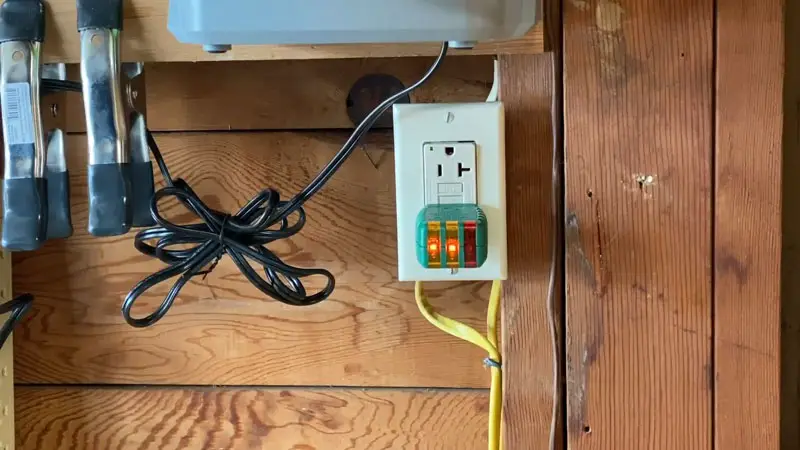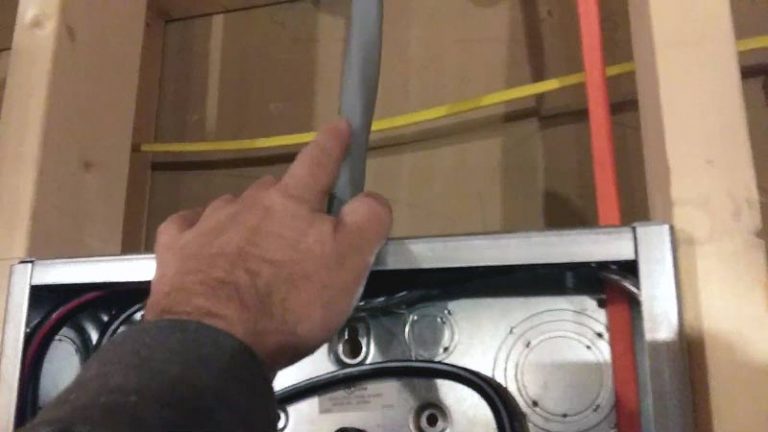Why Are the Plastics Blocking the Outlet? [Outlet Blocked by Plastic]

Outlets are a crucial part of any home or office electrical system. They provide a convenient way to plug in and power various devices and appliances. However, it can be frustrating when you try to plug something in and find that the outlet is blocked by plastic.
This issue can be caused by a variety of factors. These range from the design of the outlet to a broken or malfunctioning receptacle. In this article, we’ll explore the different types of outlets and their features. We’ll also discuss the common causes of an outlet being blocked by plastic and how to fix the issue.
By understanding more about outlets and how they work, you’ll be better equipped to troubleshoot and resolve any problems you may encounter.
You'll Learn About
Why is There Plastic in the Outlet?
Covering electrical outlets with plastic covers is an important safety measure. It can help prevent accidents, fires, and dust buildup. These covers are relatively inexpensive and easy to install. This makes them a worthwhile investment for any home. With their many benefits, it is no wonder that outlet covers are such a common sight in homes and buildings across the world.
Child Safety
The primary reason for covering electrical outlets with plastic covers is to prevent children from accidentally sticking items into the receptacles. This can help avoid electrical shock. Children, especially young ones, are naturally curious. They tend to explore their surroundings by putting things in their mouths or into small openings. Covering outlets protects them from the dangers of electrical shock.
Fire Prevention
Another reason for using outlet covers is to prevent fires. When objects are inserted into electrical outlets, it can cause a spark or short circuit. This can potentially lead to a fire. Plastic covers help prevent this type of accident by blocking access to the openings.
Dust and Debris Prevention
In addition to child safety and fire prevention, plastic covers also help keep dust and debris from entering the outlets. Dust and debris can interfere with the proper functioning of electrical devices. They can also increase the risk of fire or electrical shock. Covering outlets helps prevent this buildup. It keeps them clean and functioning correctly.
Aesthetics
Finally, outlet covers can also serve a cosmetic purpose. Outlets can be an eyesore, especially if they are not painted to match the wall color. Plastic covers can be purchased in a variety of colors to match the décor of a room. This makes the outlets blend in and improves the overall appearance of the space.
Why Are the Plastics Blocking the Outlet?
A GFCI (ground fault circuit interrupter) outlet is a type of outlet designed to protect people from electric shock. It does this by constantly monitoring the flow of electricity through the circuit. If it detects an imbalance, it shuts off the power. A GFCI outlet has a reset button. This can be pressed to restore power to the outlet if it trips.
A tamper-resistant outlet is a type of outlet with built-in mechanisms to prevent foreign objects from being inserted into the receptacle. These outlets have shutters that cover the live electrical contacts. They only open when a plug is inserted fully into the outlet. Tamper-resistant outlets are required by code in many areas. They are a safety measure to prevent children from accidentally sticking objects into the outlets.
Standard outlets, on the other hand, do not have any built-in mechanisms to prevent foreign objects from being inserted into the receptacle. These outlets are typically less expensive than tamper-resistant outlets. However, they may not provide the same level of protection against electric shock or injury.
It’s important to note that not all outlets are the same. It’s important to use the appropriate type of outlet for the application. Tamper-resistant outlets should be used in areas where children or others might accidentally come into contact with the outlets. GFCI outlets should be used in areas where there is a risk of electrical shock, such as near a sink or in a bathroom. Standard outlets can be used in other areas of the home or office.
Types of Outlets
There are three main types of outlets: standard outlets, tamper-resistant outlets, and GFCI (ground fault circuit interrupter) outlets.
Standard outlets are the most common type of outlet. They are typically found in most homes and offices. They have two or three holes for plugging in devices and appliances. They do not have any built-in mechanisms to prevent foreign objects from being inserted into the receptacle. Standard outlets are relatively inexpensive. They are suitable for most general-purpose applications.
Tamper-resistant outlets are designed to prevent foreign objects from being inserted into the receptacle. These outlets have shutters that cover the live electrical contacts. They only open when a plug is inserted fully into the outlet. Tamper-resistant outlets are required by code in many areas. They are a safety measure to prevent children from accidentally sticking objects into the outlets.
GFCI outlets are a type of outlet designed to protect people from electric shock. They do this by constantly monitoring the flow of electricity through the circuit. If they detect an imbalance, they shut off the power. GFCI outlets have a reset button. This can be pressed to restore power to the outlet if it trips. They are commonly used in areas where there is a risk of electrical shock, such as near a sink or in a bathroom.
Causes of an Outlet Being Blocked by Plastic
There are several common causes of an outlet being blocked by plastic:
Tamper-resistant Outlet Design
As mentioned previously, tamper-resistant outlets have shutters that cover the live electrical contacts. They only open when a plug is inserted fully into the outlet. If the plug is not inserted fully, the shutters will remain closed. This makes the outlet appear to be blocked by plastic. In this case, the issue can be resolved by making sure to insert the plug fully into the outlet.
Plug Not Inserted Fully
Even if you are using a standard outlet, it is still possible for the outlet to appear to be blocked by plastic. This can happen if the plug is misaligned or if the prongs are not fully inserted into the receptacle. In this case, the issue can be resolved by making sure to insert the plug fully into the outlet.
Broken Outlet
If the outlet itself is broken or malfunctioning, it may appear to be blocked by plastic. This can happen even if there is no actual blockage. This can occur if the outlet is damaged or if the internal wiring is faulty. In this case, the issue will need to be resolved by repairing or replacing the outlet.
How to Fix an Outlet Blocked by Plastic
If you are experiencing an outlet that appears to be blocked by plastic, there are a few steps you can take to try to fix the issue:
Check the Type of Outlet
Determine whether you are using a standard outlet, a tamper-resistant outlet, or a GFCI outlet. This will help you understand the possible causes of the issue and how to address it.
Make Sure the Plug is Fully Inserted
If you are using a tamper-resistant outlet or a standard outlet, make sure that the plug is fully inserted into the receptacle. This may require some maneuvering to ensure that both prongs are fully seated in the outlet.
Check for Any Visible Damage
If the outlet appears to be broken or damaged, it may be the cause of the issue. Look for any visible signs of damage, such as cracks or loose wiring.
Test the Outlet
Use a voltage tester or outlet tester to check the outlet. This will help you see if it is functioning properly. If the outlet is not functioning correctly, it may need to be repaired or replaced.
Call an Electrician
If you are unable to fix the issue or if you are unsure of the cause, it is best to call a licensed electrician for assistance. An electrician will have the knowledge and experience to properly diagnose and repair any issues with the outlet.
It’s important to note that attempting to fix an outlet or any other electrical issue without proper knowledge and training can be dangerous. This should be avoided. If you are not comfortable or capable of addressing the issue yourself, it is always best to seek professional help.
Tips to Prevent Outlet is Blocked by Plastic
Here are a few additional tips that we didn’t discuss earlier for fixing an outlet that appears to be blocked by plastic:
Check the Power Source
Make sure that the outlet is receiving power by checking the circuit breaker or fuse box. If the outlet is not receiving power, it may appear to be blocked by plastic even if there is no actual blockage.
Check for Loose Wiring
If the outlet appears to be blocked by plastic and there is no visible damage, it’s possible that the internal wiring may be loose. Carefully remove the outlet cover and check for any loose wires. If you find any, secure them firmly in place and replace the outlet cover.
Use a Different Outlet
If you are unable to fix the issue with the outlet in question, try plugging the device or appliance into a different outlet. This will help you determine whether the issue is with the outlet or the device itself.
Check for Foreign Objects
If the outlet appears to be blocked by plastic and you are unable to find any visible damage or loose wiring, it’s possible that a foreign object may be stuck in the receptacle. Carefully remove the outlet cover and check for any objects that may be causing the blockage.
Use a Different Plug
If the outlet appears to be blocked by plastic and you have ruled out all other possible causes, try using a different plug with the device or appliance. This will help you determine whether the issue is with the plug or the outlet.
Remember, if you are unsure of how to fix an outlet that appears to be blocked by plastic or if you feel uncomfortable addressing the issue yourself, it is always best to seek professional help. A licensed electrician will have the knowledge and experience to properly diagnose and repair any issues with the outlet.
Conclusion
In conclusion, outlets play a vital role in our daily lives. They provide a convenient way to power a wide range of devices and appliances. However, an outlet that appears to be blocked by plastic can be a frustrating and potentially dangerous issue.
By understanding the different types of outlets and their features, as well as the common causes of an outlet being blocked by plastic and how to fix the issue, you’ll be better equipped to safely and effectively address any problems you may encounter.
Remember to always use outlets properly and to seek professional help if you are unsure of how to fix an issue or if you feel uncomfortable addressing it yourself. Proper outlet use is essential for ensuring the safety and reliability of your electrical system.


